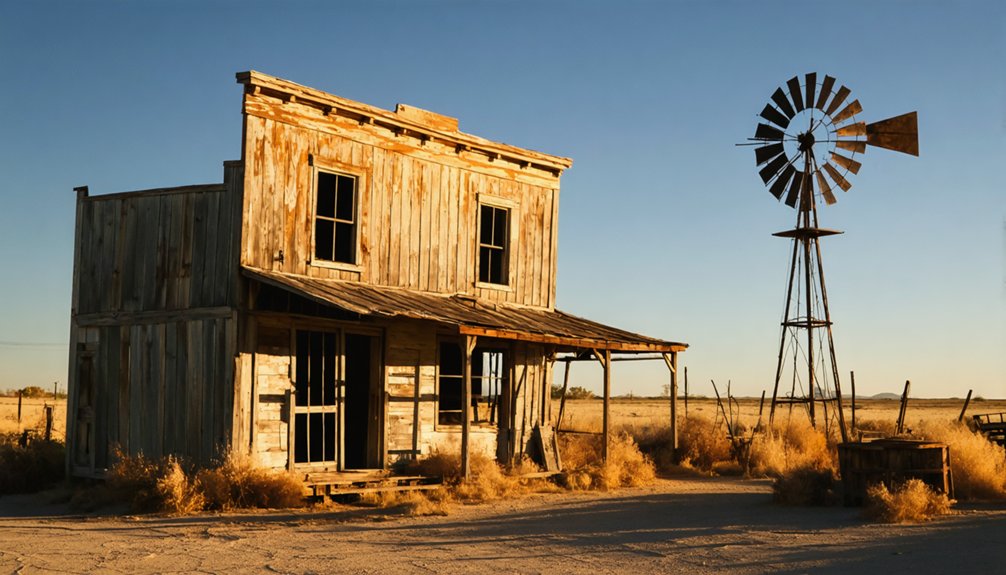You’ll find Bronco’s remains in Texas, where H. “Gravy” Fields established a general store in 1903 that grew into a thriving ranch community. The town peaked at 180 residents in 1961, supported by Walker’s Flour Mill and a cotton gin, but couldn’t diversify beyond agriculture and ranching. Today, scattered ruins and deteriorating structures mark where this frontier settlement once stood. Bronco’s story captures the essence of Texas’s vanishing frontier communities.
Key Takeaways
- Bronco was established in 1903 by H. “Gravy” Fields as a general store for ranchers, reaching its peak population of 180 in 1961.
- The town’s economy centered on cattle ranching, with Walker’s Flour Mill (1915) and a cotton gin (1947) supporting agricultural development.
- Economic isolation due to limited railroad access and inability to diversify beyond agriculture contributed to the town’s eventual decline.
- Today, Bronco is characterized by scattered ruins and deteriorating structures amid a semi-arid landscape, with minimal population.
- Local preservation groups actively work to document and protect remaining structures while maintaining the historical legacy of this frontier settlement.
From Frontier Dreams to Ghost Town Reality
While many Texas frontier towns flourished in the early 1900s, Bronco’s story began modestly in 1903 when a local cowpuncher established a store to serve the area’s ranching community.
You’ll find that frontier challenges quickly emerged as the town struggled with economic isolation, lacking the vital railroad access that powered growth in other settlements. Similar to Independence, refusing railroad access proved devastating for many Texas towns. Historic Old Pueblo Springs two miles west once served as an important watering place for Native American tribes.
Though Bronco managed to attract a flour mill in 1915 and later a cotton gin in 1947, these developments couldn’t overcome the fundamental limitations of its remote location.
Despite attracting key agricultural facilities, Bronco’s isolation proved an insurmountable barrier to sustained economic growth and development.
Despite reaching a peak population of 180 in 1961, you can trace the town’s decline through its inability to diversify beyond agriculture and ranching.
The Legacy of H. “Gravy” Fields
H. “Gravy” Fields transformed from a humble cowpuncher to Bronco’s founding father when he established the town’s general store in 1903.
You’ll find his pioneering spirit reflected in the store’s role as both a commercial hub and social center, where he served as postmaster while helping shift the frontier outpost into an established community.
A flour mill opened in 1915, further expanding the town’s economic foundations.
Fields’s entrepreneurial legacy stands as a tribute to the rugged individualism that shaped early Texas settlements, even though Bronco itself would eventually fade into ghost town status. His success in ranching led him to acquire the 07 Ranch’s 100,000 acres along the state line, where he managed over 2,000 head of cattle.
From Cowpuncher to Founder
Born in a humble log cabin near Batesville, Arkansas in 1874, H. “Gravy” Fields would transform from a simple cowpuncher into the visionary founder of Bronco, Texas. His early years immersed in cowboy culture shaped his understanding of frontier life as he worked the cattle ranges near the Texas-New Mexico border.
You’ll find Fields’ entrepreneurial spirit emerged in 1903 when he established Bronco’s first store and secured the town’s post office, becoming its inaugural postmaster. His strategic location choice along U.S. Highway 380 proved essential for community development. His success in ranching led him to acquire over 100,000 acres of land across the region.
The area’s rich history includes Sulphur Draw headwaters, which influenced early settlement patterns in the region. While the railroad never reached Bronco, Fields’ store became the crucial hub that sustained surrounding ranches and sparked the town’s growth. His transformation from cattle herder to community leader exemplifies the rugged independence of Texas frontier pioneers.
Local Store’s Pioneer Impact
Standing as a proof of frontier entrepreneurship, Fields’ general store transformed Bronco from an unmarked spot on the Texas plains into an indispensable community hub in 1903.
As a former cowpuncher with extensive ranching expertise, Fields understood the store’s significance in serving local ranchers and settlers, while strengthening crucial community ties through his role as postmaster. Similar to the Fields Store post office that operated from 1874 to 1909, the establishment served as a vital communication link for the region. Located along U.S. Highway 380, the store’s strategic position near the New Mexico border made it accessible to travelers and local residents alike.
- The store anchored Bronco’s economic foundation, leading to a population of 25 by 1912
- Fields’ experience managing 500 cattle and 15 saddle horses enhanced his ability to serve ranching customers
- The establishment attracted additional businesses, including a flour mill in 1915 and a cotton gin in 1947
You’ll find that Fields’ legacy lives on in local histories, marking his store as the catalyst that established Bronco’s identity and infrastructure.
His Enduring Frontier Spirit
The enduring legacy of “Gravy” Fields extends far beyond his role as a merchant and postmaster.
You’ll find his pioneer resilience reflected in how he established Bronco’s first store and post office in 1903 without existing infrastructure, demonstrating the self-reliant spirit that defined Texas frontier settlers.
Fields’ impact on community identity runs deep – from securing the town’s distinctive name after spotting a bucking bronco to creating a crucial hub for surrounding ranches. Today, his contributions are preserved through digital asset management that helps maintain records of early Texas settlements.
Operating from a covered wagon store, Fields exemplified the resourcefulness required of early Texas merchants.
As a former cowpuncher himself, he embodied the rugged determination needed to survive in remote conditions near Sulphur Draw.
Despite the town’s limited growth due to lack of railroad access, Fields’ entrepreneurial drive and adaptability kept Bronco functioning as a modest but persistent settlement well into the mid-20th century.
Early Settlement and Town Establishment
In 1903, cowpuncher H. “Gravy” Fields established Bronco as a service point for local ranchers near western Yoakum County, Texas. The town’s name originated from a traveling salesman who spotted a cowboy wrestling with a bucking horse, perfectly capturing the spirit of early ranching in the region.
A frontier ranching town born from a cowboy’s struggle with a wild bronc on Texas soil.
Located about 70 miles southwest of Lubbock, Bronco’s strategic position near Old Pueblo Springs made it an ideal settlement for the frontier community.
- The initial general store served as the town’s cornerstone, providing essential supplies to local ranchers.
- By 1912, community resilience helped grow the population to 25 residents.
- The town’s proximity to Sulphur Draw’s headwaters guaranteed reliable water access for livestock and settlers.
The absence of railroad connections would later challenge Bronco’s expansion, but these early years marked a determined beginning for this Texas frontier outpost.
Life in Early 1900s Bronco
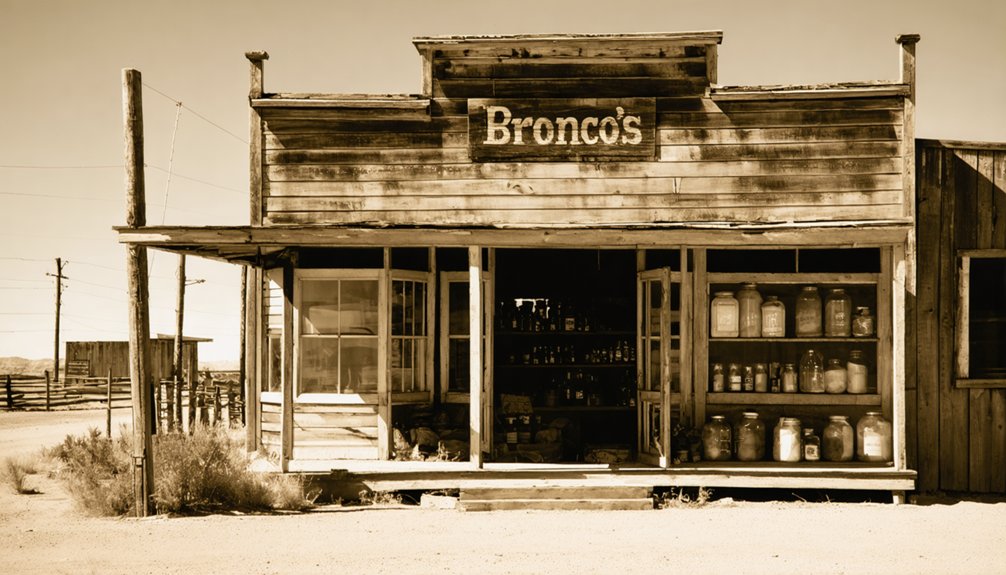
Life in early 1900s Bronco epitomized the rugged determination of Texas frontier settlements, where daily routines centered on cattle ranching and basic survival.
You’d find yourself in a close-knit community of ranchers and their families, living in simple wood or adobe homes without modern conveniences, drawing water from wells or springs.
Community gatherings brought folks together for barn raisings, church services, and local markets, strengthening bonds essential for frontier living.
Education challenges meant children learned in a one-room schoolhouse, if at all.
You’d rely on horseback and wagons for transportation, while dirt roads turned treacherous in bad weather.
Daily life demanded self-reliance, from treating ailments with home remedies to bartering goods with neighbors.
The isolation fostered a spirit of independence, though threats from rustlers and harsh environmental conditions tested your resilience.
Economic Pillars of a Ranch Town
Behind Bronco’s frontier lifestyle lay a robust economic foundation built on four major pillars: cattle ranching, open range land use, railroad access, and skilled vaquero labor.
You’d find ranch management techniques centered around Texas longhorns, known for their resilience and self-sufficiency. Cattle branding and roundups were essential practices across the vast rangelands, where vaqueros and cowboys showcased their expertise in maintaining herds.
Key elements that shaped Bronco’s economic strength included:
Bronco’s economic prowess rested on vital pillars that transformed frontier ranching into a powerful commercial enterprise.
- Railroad expansion that connected ranchers to lucrative northern markets, where cattle prices soared six times higher
- Open range grazing that supported massive operations like King Ranch, managing 20,000 head on 825,000 acres
- Skilled vaquero labor that brought essential cattle handling techniques, from roping to branding, forming the backbone of ranch operations
The Rise and Fall of Walker’s Flour Mill
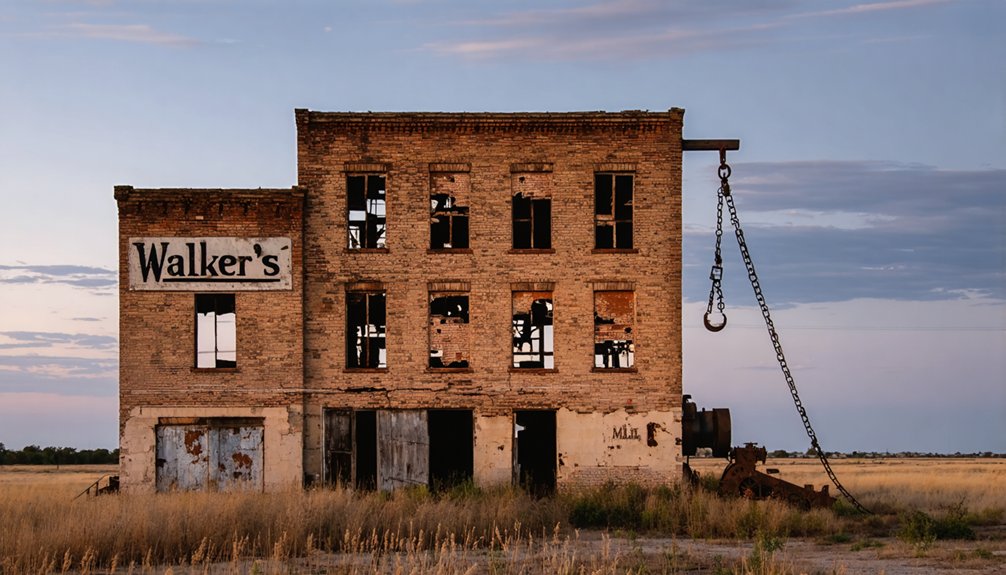
L.W. Walker’s ambitious vision took shape in 1915 when he established his flour mill in Bronco, introducing essential grain processing capabilities to the Texas Panhandle region.
You’d find the mill’s machinery humming with activity as it transformed local wheat harvests into marketable flour, creating steady employment for the town’s workforce.
The mill’s presence quickly established Bronco as a significant agricultural processing hub, attracting related businesses and fostering economic growth throughout the rural community.
Mill Operations Begin 1915
In 1915, Walker’s Flour Mill emerged as a significant enterprise in Bronco, Texas, transforming the town’s economic landscape. L.W. Walker’s milling innovations positioned the operation as a cornerstone of local commerce, establishing essential agricultural partnerships with area wheat farmers.
You’ll find that the mill’s impact extended beyond basic grain processing, creating a ripple effect throughout Bronco’s economy.
Here’s what made the mill indispensable:
- Served as a primary employer, boosting local job opportunities
- Provided critical wheat processing services to regional farmers
- Connected agricultural producers to broader markets
The mill’s operations aligned perfectly with the region’s farming focus, creating a sustainable economic model that would support Bronco’s growth for years to come.
Rail connections later enhanced the mill’s reach, strengthening its position in Texas’s agricultural network.
Equipment and Milling Process
Walker’s Flour Mill operated with essential milling equipment typical of early 20th-century operations, including grinding stones and roller mills for processing grain into flour.
You’d find multiple stages of grinding and sifting machinery designed to refine the flour to precise textures and purity levels. Before milling began, the grain underwent thorough cleaning to remove chaff and impurities.
The mill’s milling machinery also supported smaller sawmill operations, with “peckerwood” or “doodlebug” equipment capable of cutting 10,000 feet daily.
By 1947, you’d see additional cotton ginning equipment on site, expanding the mill’s agricultural processing capabilities.
Unfortunately, during the Great Depression, equipment failures plagued the original sawmill component, leading to its shutdown and signaling early challenges in maintaining the facility’s aging machinery.
Local Economic Impact
Establishing a pivotal economic cornerstone for Bronco in 1915, the flour mill transformed this Texas settlement into a bustling agricultural hub.
You’ll find that Walker’s Mill drove community resilience through direct employment and sparked agricultural diversification, particularly when a cotton gin opened in 1947.
The mill’s influence on Bronco’s economy extended beyond its walls:
- Created sustainable jobs that supported multiple generations of local families
- Attracted complementary businesses, strengthening the local trade ecosystem
- Stimulated growth in farming ventures across surrounding areas
When economic downturns hit, including the Great Depression, the mill’s presence helped the community weather difficult times.
However, increasing competition from larger mills eventually led to its decline, triggering a gradual exodus of residents seeking opportunities elsewhere.
Daily Life in a Texas Panhandle Community
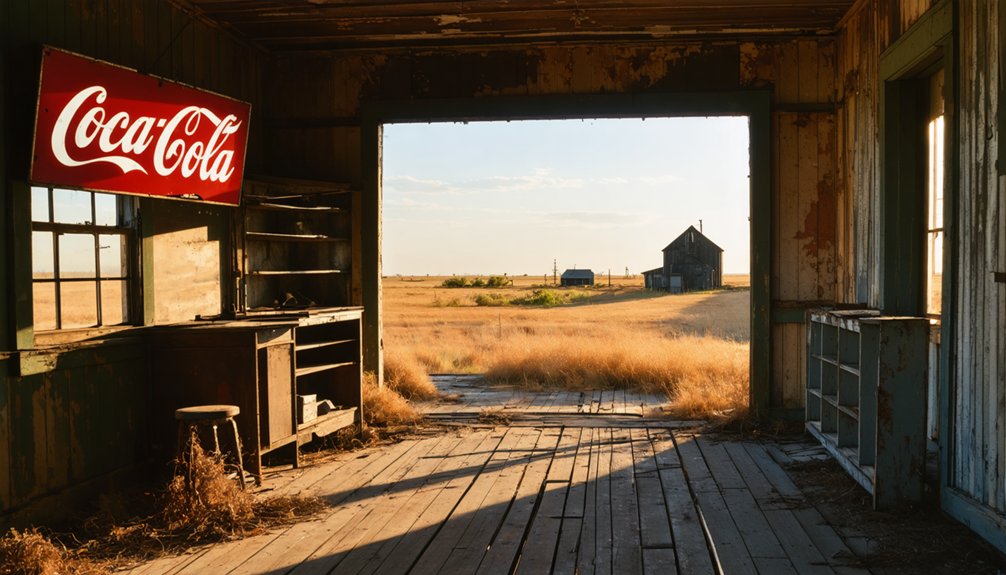
Life in early Bronco revolved around the demanding rhythms of ranching and farming, with residents adapting to the harsh Panhandle environment through communal support and self-reliance.
You’d find yourself participating in community interactions ranging from church gatherings to shared labor, while your daily agricultural practices included tending cattle, growing cotton, and preserving food for the variable seasons.
Living in one of the town’s utilitarian wooden structures, you’d rely on local resources and businesses like the Enterprise newspaper and community bank.
Your diet would combine ranch-raised livestock with home-grown crops and wild-gathered plants.
Children attended small local schools, while adults worked the land or provided essential services like blacksmithing.
Social life centered around rodeo activities, horseback riding, and communal events that strengthened the town’s resilient spirit.
Bronco’s Role in Regional Ranch Operations
Beyond its days as a frontier settlement, Bronco evolved into a significant hub for regional ranching operations.
You’ll find its transformation marked by strategic cattle drives and robust ranch security measures that protected valuable livestock in the challenging Texas Panhandle frontier.
The ranch’s significance grew through several operational phases:
- Long-time residents initially operated it as a cattle ranch before adapting it into a dude ranch
- Julian Bivins’s influence shaped the region through large-scale ranching operations
- Cal Farley Boy’s Ranch’s acquisition in 1939 introduced innovative youth-focused ranching programs
The surrounding open grasslands proved ideal for grazing, while repurposed buildings from the original settlement supported expanding ranch operations.
Bronco’s strategic location within regional cattle markets helped sustain its economic viability through changing times.
Remnants of a Forgotten Settlement
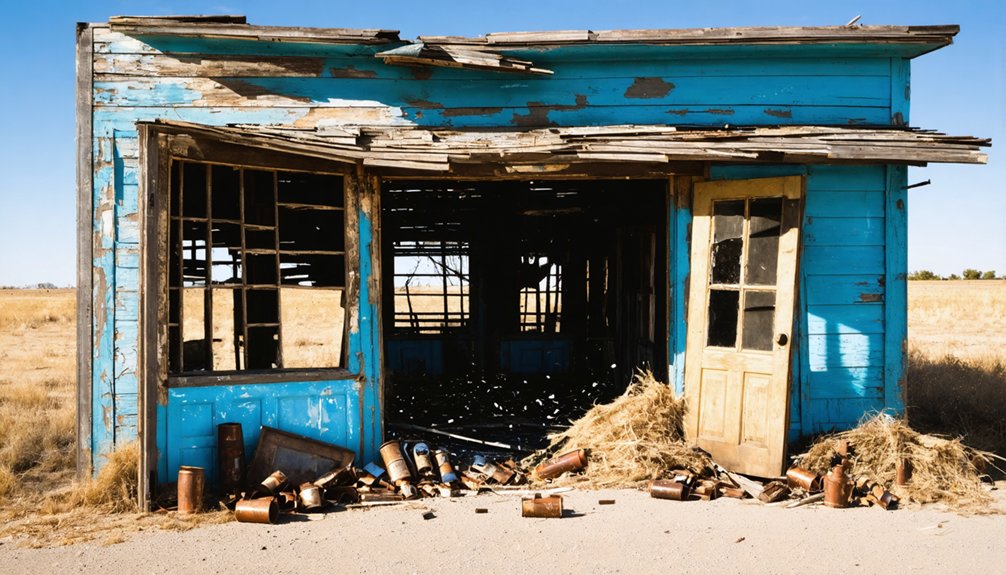
Today’s Bronco stands as a stark indication of the impermanence of frontier settlements, with only scattered ruins marking its historical footprint.
You’ll find few forgotten artifacts from its once-bustling past – no intact commercial buildings remain from the original store or the 1915 flour mill. The 1947 cotton gin, while still present, has succumbed to decades of neglect and disuse.
The settlement patterns of Bronco reflect the harsh realities of frontier life. While the flat plains and proximity to Old Pueblo Springs once made it an attractive location for settlers, the lack of railroad access and isolation ultimately sealed its fate.
What remains is primarily undeveloped land, with deteriorating structures serving as silent witnesses to a community that once called this semi-arid landscape home.
Preserving Bronco’s Historical Memory
As efforts to preserve Bronco’s historical legacy gain momentum, local preservation groups have implemented extensive strategies aligned with national standards.
Community preservation initiatives focus on documenting and protecting what remains of this Texas ghost town through historical documentation, public engagement, and strategic planning.
Dedicated preservationists work to safeguard Bronco’s remaining structures while engaging local communities in protecting this historic Texas landmark.
You’ll find these key preservation activities in Bronco:
- Thorough historical surveys and inventories tracking existing structures and artifacts
- Public education programs featuring interpretive signage and collaborative workshops with local historical societies
- Development of research packets and templates enabling community-led documentation efforts
Through these measures, you’re witnessing a transformation in how Bronco’s story is preserved.
The combination of structural stabilization efforts and active community engagement guarantees that future generations will understand this settlement’s significance in Texas history.
Frequently Asked Questions
Were Any Notable Outlaws or Lawmen Associated With Bronco’s History?
Like a lone rider emerging from legend, you’ll find “Bronco Bill” Walters stands as the notable outlaw tied to your town’s past, though lawmen legacies remain largely shrouded in mystery.
What Was the Average Price of Land in Bronco During Its Peak?
You’d find land values in Bronco during its peak likely ranged from 50 cents to $5 per acre, following typical West Texas economic trends, though exact records aren’t available for confirmation.
Did Bronco Have a School or Church During Its Active Years?
You won’t find documented school history or church significance in Bronco’s records. While residents likely had religious gatherings and educational arrangements, there’s no evidence of dedicated buildings for either purpose.
What Happened to the Original Buildings and Property Deeds of Bronco?
Like Ozymandias’s ruins, you’ll find Bronco’s building remnants have largely crumbled or been moved elsewhere. Property ownership records were absorbed by larger entities or relegated to county archives after the town’s abandonment.
Were There Any Major Natural Disasters That Affected Bronco’s Development?
You won’t find records of any major flood damage or drought impact affecting Bronco’s development. Unlike other Texas ghost towns destroyed by natural disasters, Bronco’s decline stemmed from economic and infrastructural limitations.
References
- https://www.youtube.com/watch?v=bbVM_-giQIE
- https://www.southernthing.com/ruins-in-texas-2640914879.html
- https://en.wikipedia.org/wiki/List_of_ghost_towns_in_Texas
- https://discovertexasoutdoors.com/places/bronco/
- https://www.tshaonline.org/handbook/entries/bronco-tx
- https://www.texasescapes.com/TexasPanhandleTowns/BroncoTexas/BroncoTexas.htm
- https://www.texasalmanac.com/places/bronco-0
- https://www.texasescapes.com/TOWNS/Texas-Ghost-Towns-5-Texas-Panhandle.htm
- https://www.amysatticss.com/ghost-towns/
- https://www.youtube.com/watch?v=RF3pZD4RWSQ
